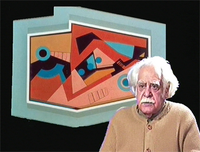Rivera (Uruguai), 1913 – Savigny-sur-Orge (França), 2010
Por Francisco Alambert
 Born on the border between Uruguay and Brazil, Carmelo Arden Quin became interested in the visual arts in 1932 through the Catalan writer Emilio Sans. In 1935, he met Joaquín Torres-García (1874-1949), one of the main theorists of Latin American constructivism. That same year, Arden Quin’s work transitioned from pedagogical cubism to geometric abstraction. In 1936, he participated in a collective exhibition of Río de la Plata artists at El Ateneo in Montevideo, alongside Torres García, Rafael Barradas (1890-1929), and Juan Del Prete, among others. He exhibited three cut-out silhouettes painted in primary colors, closely aligned with Mondrian’s chromatic trilogy.
Born on the border between Uruguay and Brazil, Carmelo Arden Quin became interested in the visual arts in 1932 through the Catalan writer Emilio Sans. In 1935, he met Joaquín Torres-García (1874-1949), one of the main theorists of Latin American constructivism. That same year, Arden Quin’s work transitioned from pedagogical cubism to geometric abstraction. In 1936, he participated in a collective exhibition of Río de la Plata artists at El Ateneo in Montevideo, alongside Torres García, Rafael Barradas (1890-1929), and Juan Del Prete, among others. He exhibited three cut-out silhouettes painted in primary colors, closely aligned with Mondrian’s chromatic trilogy.
In 1936, he created non-orthogonal paintings, breaking the traditional boundaries of the rectangular format. These works were exhibited at Casa de España in Montevideo, as part of an event supporting the Spanish Republic. In 1938, Arden Quin moved to Buenos Aires, Argentina, where he became involved in intellectual circles. He contributed to the Siesia magazine and co-founded the periodical El Universitario in 1942.
In 1944, he participated in the Arte Concreto-Invención movement with artists such as Gyula Kosice and Tomás Maldonado. He was one of the directors of the legendary magazine Arturo, where he published a programmatic manifesto titled “La dialéctica,” advocating for the idea that new art should be pure invention. During this period, he painted the constructivist canvas Points noirs (Black Dots, 1945). Arden Quin was one of the founders of the Madí group (an acronym representing “Movement, Abstraction, Dimension, and Invention”). He participated in exhibitions and performances until 1947, when a split occurred within the group. One faction, led by Kosice and Rothfuss, remained in Argentina under the name Madimensor, while Arden Quin led the other.
In Buenos Aires, Arden Quin also co-founded the Asociación Arte Nuevo, which brought together artists from different non-figurative movements. He moved to Paris in 1948 and exhibited at the Salon des Réalités Nouvelles from 1949 to 1956. In 1949, he took part in the Madí Exhibition at the Colette Allendy Gallery in Paris.
Influenced by Georges Vantongerloo and Michel Seuphor, Arden Quin began producing monochromatic works or pieces that explored the use of white. Notable works from this period include his mobile reliefs Le chien (1949-1950) and Le chat (1950). He founded the magazine Ailleurs in Paris and participated in the Concrete Poetry Movement in the 1960s. After creating various sculptures and collages throughout the 1960s and 1970s, Arden Quin returned to painting in 1971. Major retrospectives of his work were held in France in 1978 and 1988.
In 1990, Arden Quin exhibited his works at the Rachel Adler Gallery in New York, and from that time, he continued to produce prolifically, with exhibitions in Zaragoza (1996), followed by major retrospectives at the Museo Reina Sofía in Madrid, the Museo Iberoamericano in Cáceres, and the Fondazione Antonio Mazzotta in Milan. In 1992, he was a key figure in founding the Asociación Madí Internacional, based in Paris. Another major retrospective was held at the Museo de Arte Contemporáneo de La Plata (MACLA) in 2000. He participated in the collective exhibition Latin American Artists of the 20th Century at the Museum of Modern Art in New York in 1993 and in the 2001 historical retrospective Abstract Art from Río de la Plata, Buenos Aires and Montevideo 1933/53 at The Americas Society in New York. He passed away in September 2010 in France at the age of 97.


